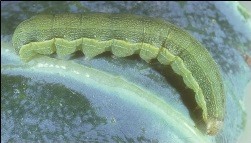ABSTRACTFertilizers are commonly applied to plants in both agricultural and ornamental settings and these fertilizers can affect insect herbivores. Beet armyworms, Spodoptera exigua, are phytophagous insects that are easy to rear in the lab. In this exercise, students design an experiment that manipulates plant quality via fertilizer application and then measure the effect of fertilization on caterpillar performance. In the first class, students design the experiment and apply the treatments. In subsequent weeks, students conduct a feeding trial where they collect and analyze data on caterpillar performance. Each student writes a lab report based on class data. AUTHORSCaralyn B. Zehnder Springfield Technical Community College, Office of Learning Engagement & Advancement, Springfield, MA 01105, czehnder@stcc.edu CLASS TIMEOne 2-3 hour class period for design and implementation of experiment (week 1). 15-30 minutes in class for caterpillar weighing during weeks 4 and 5 (or you can end the experiment after week 4). One 2-3 hour class period to review t-tests and graphing (week 5). One hour for peer review (this could be accomplished outside of class). OUTSIDE OF CLASS TIMEStudents will spend approximately 1 hour per week during weeks 1 – 4 designing their experiment and taking care of plants and caterpillars. They will spend several hours analyzing class data, finding and reading journal articles, commenting on a peer review and writing papers based on their results. STUDENT PRODUCTSEach student submits a short description of a proposed experimental design. Each student writes a lab report in the style of Ecology based on the class data. SETTINGThe experiment is carried out entirely in the lab. You will need a small amount of space to grow plants and rear caterpillars. For a lab section of 24 students, you will need approximately 1m2 for growing plants and another 1m2 for rearing caterpillars. COURSE CONTEXTThe experiment as described is used in a sophomore-level ecology course with a maximum of 24 students per lab section. INSTITUTIONThis experiment has been conducted at a small public liberal arts university. TRANSFERABILITYThis experiment is a guided-inquiry exercise, so it can be transferred to other levels by providing more or less guidance to the students in terms of experimental design and data analysis. This experiment could be conducted with wide variety host plant species (cotton, soybeans, collards, lettuce). Other phytophagous insects that are easily reared in the laboratory such as the tobacco hornworms (Manduca sexta) and the cabbage white butterfly (Pieris rapae), could be used. Besides fertilizer, other treatments could be used such as comparing different plant species, the presence or absence of a mutualism if legumes and rhizobia are used, or soil moisture levels. DOWNLOADSDescription of other Resource Files:
ACKNOWLEDGMENTSThis submission was greatly improved by comments and suggestions from Christopher Beck and the TIEE anonymous reviewers. I thank A. VandeVoort and K. Manoylov for helpful course discussions. Finally, I thank the many students who have enrolled in my Ecology course at Georgia College and participated in this laboratory exercise. CITATIONCaralyn Zehnder. 16 March 2016, posting date. Effects of plant quality on caterpillar performance Teaching Issues and Experiments in Ecology, Vol. 11: Experiment #1 [online]. https://tiee.esa.org/vol/v11/experiments/zehnder/abstract.html |

https://entnemdept.ufl.edu/creatures/veg/leaf/beet_armyworm.htm Larva of the beet armyworm, Spodoptera exigua (Hübner). Photograph by John Capinera, University of Florida. Used with permission. full size image |
<top> | |